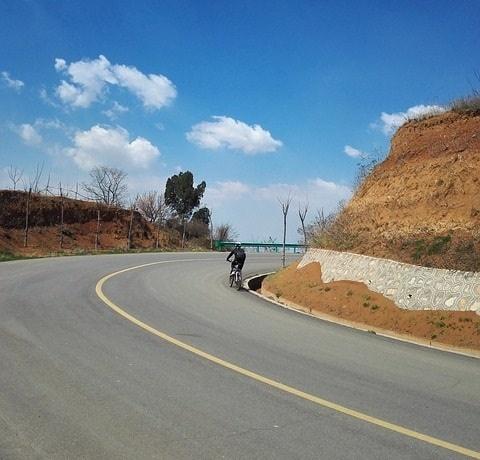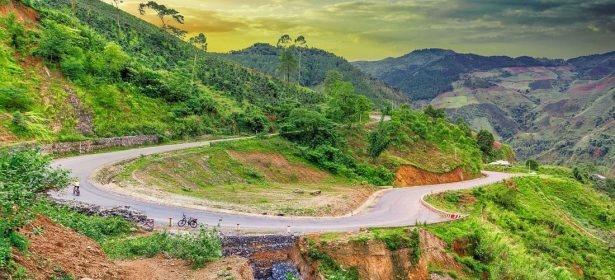Riding uphill is one of the biggest challenges in cycling. It can be a struggle, sapping strength and speed. Unfortunately, there’s no silver bullet to get up climbs easier, but there are some tips you can follow to make riding uphill more comfortable.
Check out the 8 top tips below.
1) Weight
The heavier you are, the harder every climb will be. It’s no surprise that elite climbers on the professional tour are all lightweight. The better your power to weight ratio is, the easier the climb will be.
Losing a few pounds is a quick way to make climbing a lot easier – and you’ll get the additional health and fitness benefits too.
2) Training

Unfortunately, biking uphill only really becomes easier if you do it regularly. The more hills you climb, the less tired you’ll get. Make sure you incorporate hilly routes into your training and embrace them.
Don’t avoid hills and stick to flat surfaces as you’ll struggle when the terrain kicks up. Hilly rides are the best way to prepare for climbing. If you live in a flat area, indoor trainers do a good job with mimicking hills.
3) Get your gears right
Choosing the wrong gear on a climb is a sure-fire way to burn out. If you are in a gear that’s too big, you’ll find your energy draining quicker and your efficiency will drop. In fact, you’ll end up being slower too.
The more gears you have, the easier the climbing will be. If in doubt, opt for a lower gear (your easiest cog) and then you can always change up a gear if need be.
4) Pacing the climb

It’s tempting to really attack climbs and get up them as fast as possible, but you’ll end up tiring yourself out a lot quicker. Pacing is really important to effective cycling uphill.
Don’t fall into the trap of racing up the hill straight away, settling in and finding the right gear will lead to a more enjoyable ride.
5) Fuel for more power
Regardless of cycling on hills or flat terrain, fueling is vital. If you want to have more energy for getting up climbs, make sure you have food beforehand and you are well hydrated.
Poor fueling quickly leads to low energy and tiredness. If you need a quick boost before a hill, energy gels are popular nutritional products cyclists use for an instant energy hit.
6) Cycling technique
If you feel like you are wasting a lot of energy on climbs, think about your cycling technique. If you are moving around in the saddle too much, you’ll be wasting energy.
Likewise, using your gears optimally is important for efficient cycling uphill. Some small tweaks can help conserve your energy levels and reduce tiredness.
7) Ride in a group
If you’ve ridden in a group before, you’ll already know the benefits of ‘drafting’. Have a look at professional races and you’ll see the main peloton cycling in a big group to conserve energy.
Cycling with other people means you can sit in behind someone else and receive an aerodynamic boost. This is especially important if there is a headwind. Sitting in behind another rider, known as drafting, results in between a 10-30% energy saving.
Obviously, if you are the lead rider, you’ll be doing more of the hard work. Riding in a group is a really effective way to save energy while maintaining speed. Just make sure you are confident with group riding before getting too close to another rider’s back wheel.
8) Preparation
It goes without saying that having the right bike, clothing and equipment makes cycling easier.
There are some quick things you can do to prepare for hills: Upgrade your wheels for lighter ones that perform better going uphill, make sure your bike is suitable for climbing, with a wide range of gear options, reduce weight on your bike by avoiding additional bags and so on, wear sweat wicking clothing to keep you cool when you are working hard, and make sure you’ve got water bottle cages for hydration.
If you are climbing during a sportive event or race, you can ditch some fluids and make the most of the feed stations instead. That’ll keep your overall weight on the bike lower.
Getting your preparation right will be a big game-changer for improving efficiencies and generally make cycling easier. Preparation also includes knowing the route. It helps with cycling uphill when you know when the climbs are coming.
You can then save energy beforehand, fuel at the right time, build up speed to help the start of the climb and so on. Mentally, as well, being prepared is an easy way to be ready for uphill climbs.
Conclusion
Finally, here are five summarizing common mistakes to avoid:
- Over gearing on the climb
- Not having the right bike and gear options for climbing
- Excessive body movement when cycling uphill
- Avoiding hills on training rides
- Poor nutrition and hydration before hills
Remember, cycling uphill will only get easier if you do it more. These tips will help with cycling efficiency and energy levels, but nothing can replicate hill training. The more you do it, the easier it will get.
Images credit: Pixabay

Founder of Vivi Nation, the cycling, running and active living brand. Chris is a sports enthusiast, occasional triathlete and experienced cyclist, having led multiple cycle tours across Europe.


![How To Convert From Quill To Modern Threadless Stem [With A Quill Stem Adapter] How To Convert From Quill To Modern Threadless Stem [With A Quill Stem Adapter]](https://biketestreviews.com/wp/wp-content/uploads/2023/05/Fitting-A-Quill-Stem-Adapter-min-500x300.jpg)